A군 연쇄상구균 인두염(A군 연쇄상구균 인두 편도염/A군 연구균성 인두 편도염) Group A streptococcal pharyngitis(Group A streptococcal pharyngotonsillitis)
| A군 베타 용혈성 연쇄상구균(A군 연쇄상구균) 인두 편도염의 원인 |
- A군 베타 용혈성 연쇄상구균(Group A, beta hemolytic streptococcus/Group A streptococcus)이 인두에만 감염되어 인두염만 생겼을 때 A군 베타 용혈성 연쇄상구균 인두염이라고 한다.
- 편도에만 감염되어 편도염만 생겼을 때는 A군 베타 용혈성 연쇄상구균 편도염이라고 한다.
- 인두와 편도에 동시 감염되어 인두염과 편도염이 동시 생겼을 때는 A군 베타 용혈성 연쇄상구균 인두편도염 또는 A군 연쇄상구균 인두염 이라 한다.
- 이론적으로 이렇지만, 실제로는 인두와 편도는 협소한 인두 강에서 서로 이어져 있기 때문에 감염성이 아주 강한 A군 베타 용혈성 연쇄상구균이 인두에만 감염되지도 않고 편도에만 감염되지도 않고 인두와 편도에 동시 감염되어 A군 베타 용혈성 연쇄상구균 인두염과 A군 베타 용혈성 연쇄상구균 편도염이 동시 생기는 것이 일반적이다.
- 다시 설명하면, A군 베타 용혈성 연쇄상구균이 목안 즉 인두 강에 감염 될 때는 인두에만 또는 편도에만 따로따로 감염될 수 없다.
- 그래서 인두와 편도에 동시에 감염되어 그 두 부분에 감염병을 동시 일으켜 A군 베타 용혈성 연쇄상구균 인두 편도염이 생기는 것이 보통이다.
- A군 베타 용혈성 연쇄상구균 감염병 이외 다른 종류의 박테리아 감염이나 아데노바이러스 등 다른 바이러스 감염으로 인두 강 감염병이 생길 때도 마찬가지로 편도에만, 또는 인두에만 감염병이 따로따로 생기지 않고 편도와 인두 두 부분에 동시 감염병이 생기는 것이 보통이다.
- 그런데도 A군 베타 용혈성 연쇄상구균 감염으로 생긴 인두편도염을 A군 베타 용혈성 연쇄상구균 인두염, A군 베타 용혈성 연쇄상구균 인두편도염, A군 베타 용혈성 연쇄상구균 편도염, 또는 A군 연쇄상구균 인두염을 임상에서 다른 병과 같이 취급하기도 하고 다른 병명을 붙여 부르기도 하고 다른 병명을 붙여 쓰는 때도 있기 때문에 의사도 환자도 혼동할 때가 많다.
- 여기서 이 네 가지 병명은 사실은 의학적으로 같은 병명이다.
| A군 베타 용혈성 연쇄상구균 인두 편도염의 증상 징후 |
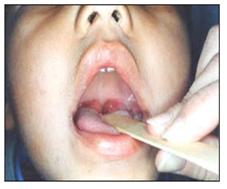
사진 54. A군 베타 용혈성 연쇄상구균 인두염과 편도염으로 편도가 붓고 빨갛다.
출처-Copyrightⓒ 2011 John Sangwon Lee,MD., FAAP
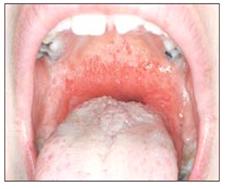
사진 55.A군 베타 용혈성 연쇄상구균 인두염과 편도염으로 편도가 붓고 연구개(입천장)가 빨갛다. 여기서 분 편도염은 보이지 않는다. 하얀 곱이 혓바닥에 끼어 있다.
출처-Copyrightⓒ 2011 John Sangwon Lee,MD. FAAP
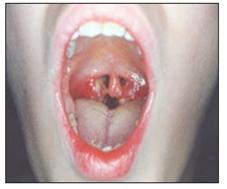
사진 56.심한 A군 베타 용혈성 연쇄상구균 인두염과 편도염.
편도가 붓고 빨갛고 흰 곱이 꼈다. 목젖염으로 목젖이 붉고 부어 있다.
출처-Copyrightⓒ 2011 John Sangwon Lee, MD., FAAP

사진 57.심한 A군 베타 용혈성 연쇄상구균 인두염과 편도염. 붓고 빨간 편도에 곱이 끼었다.
출처-Copyrightⓒ 2011 John Sangwon Lee, MD., FAAP
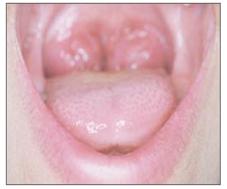
사진 58. A군 베타 용혈성 연쇄상구균 편도염과 인두염
편도염으로 양쪽 편도가 상당히 비대 됐다.
출처-Copyrightⓒ 2011 John Sangwon Lee,MD.,FAAP
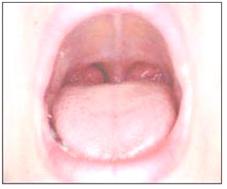
사진 59. A군 베타 용혈성 연쇄상구균 편도염과 인두염으로 양쪽 편도가 조금 부었다.
출처-Copyrightⓒ 2011 John Sangwon Lee, MD.,FAAP
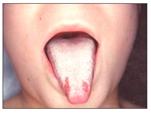
사진 60. A군 베타 용혈성 연쇄상구균 감염으로 편도염도 생길 수 있고 성홍열도 생길 수 있다. 성홍열의 증상 징후로 혓바닥에 하얀 백태가 낄 수 있고 그 다음, 그 혀가 빨간 딸기 색과 비슷한 빨간 혓바닥 색으로 일시적으로 변할 수 있다.
출처-Copyrightⓒ 2011 John Sangwon Lee, MD.,FAAP
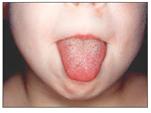
사진 61.A군 베타 용혈성 연쇄상구균 감염이 편도에 생겼고 성홍열도 생길 수 있다.
이 때 성홍열의 증상 징후로 처음에는, 혓바닥에 하얀 백태가 낄 수 있고 그 다음에는 그 혀가 빨간 딸기 색과 비슷한 혓바닥 색으로 변할 수 있다.
출처-Copyrightⓒ 2011 John Sangwon Lee, MD., FAAP
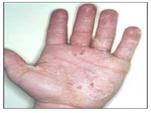
사진 62. A군 베타 용혈성 연쇄상구균 감염이 편도와 인두에 생길 수 있고 성홍열도 생길 수 있다. 성홍열로 손바닥의 피부의 각질층이 얇게 벗겨졌다.
출처-Copyrightⓒ 2011 John Sangwon Lee, MD., FAAP
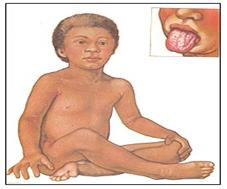
그림 63. A군 베타 용혈성 연쇄상구균 감염이 편도에 생기고 성홍열도 생길 수 있다. 성홍열을 앓을 때 사포와 비슷하게 도돌도돌한 피부 발진이 생길 수 있다. 피부 발진의 색은 붉은 것이 보통이다.
출처; Used with permission from Health information service Merk Sharp & Dome, West Point, PA
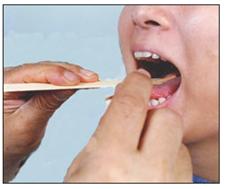
사진 64. A군 베타 용혈성 연쇄상구균 세균 배양 검사를 하기 위해 또는 항체 항원 응급 반응 검사를 하기 위해 인두 점막에서 점액을 채취한다.
출처-Copyright ⓒ 2012 John Sangwon Lee, MD., FAAP
| A군 베타 용혈성 연쇄상구균(성) 인두 편도염의 증상 징후는 나이, 병의 경과, 합병증 따라 다음과 같다. |
- 편도가 붉어지고, 붓고, 곪으면서 커지면서, 목안이 몹시 아프다.
- 또 미열 내지 고열이 나고, 두통, 복통, 구토 등의 증상 징후가 생기면서 팔다리와 전신이 아프다.
- 환아가 독성상태에 빠져 있는 것이 보통이다.
- 전등불로 목안 속 인두 강과 편도를 비춰 들여다보면 편도, 인두강 점막과 연구개가 빨개진 것을 볼 수 있다.
- 이 병이 발병된 후 2~3일이 되었을 때 편도에 하얀 고름과 곱이 끼고, 편도가 크게 부어 있는 것을 쉽게 볼 수 있다.
- 턱 바로 밑 목 부위에 있는 림프절들이 부을 수 있고, 또 그것을 손으로 만지면 조금 아플 수 있다.
- 이 병은 초기에 항생제로 적절히 치료해 주지 않으면 점점 더 악화되는 것이 보통이다.
- 더 심해지면 인두가 점점 더 아프고, 침과 음식물을 삼키기 어려울 정도로 인두통이 더 심하게 된다.
- 어떤 때는 환아가 몹시 아파 보이고 놀기를 싫어하며 잠만 자려고 한다.
- 독성 상태로 빠지기도 한다.
- 식욕이 떨어져서 음식물을 잘 먹지 않으며 잠을 비정상적으로 많이 자거나 때로는 아파서 잘 자지 못한다.
- A군 베타 용혈성 연쇄상구균에는 여러 종류의 균종들이 있고 그 균종들 중 발적 독소를 생성하는 균종이 있다. 그 발적 독소 생성 균종 감염으로 인두편도염이 생길 수 있고 그 균종에 감염되면 성홍열이 나타날 수 있다. 성홍열 참조
- A군 베타 용혈성 연쇄상구균 인두편도염이 있으면서 피부 발진이 생기면서 처음에는, 혓바닥에 흰 곱이 끼었다가 그 다음에는 빨간 딸기 색과 비슷하게 혓바닥이 빨갛게 변하는 증상 징후가 있을 때 인두 편도염을 A군 베타 용혈성 연쇄상구균 인두편도염이라고 병명을 붙이고 진단하는 대신 성홍열이란 병명을 붙여 진단한다.
- A군 베타 용혈성 연쇄상구균 감염으로 인한 인두 편도염을 적절히 치료해 주지 않으면 생명에 위험한 급성 사구체신염, 류마티스 열 등 여러 가지 합병증이 생길 수 있다. [부모도 반의사가 되어야 한다-소아가정간호백과]-제11권 소아청소년 심장 혈관계 질환-류마티스 열, 류마티스 심장염 (Rheumatic carditis), 패혈증, 중이염, 축농증, 골수염, 류마티스 관절염 참조.
| A군 베타 용혈성 연쇄상구균 인두염의 진단 |
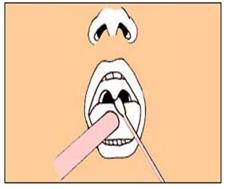
그림 65 .A군 베타 용혈성 연쇄상구균을 세균배양하거나 A군 베타 용혈성 연쇄상구균 항원 항체 응집반응 검사를 하기 위해 인두나 편도의 점막에서 점액을 면봉으로 채취한다.
출처-Copyright ⓒ 2012 John Sangwon Lee, MD.. FAAP
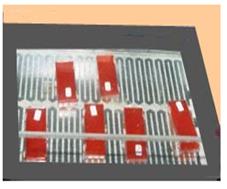
사진 66.인두 점막층에서 채취한 점액을 혈액 우무 세균배양지에 묻힌 후 그 세균 배양지를 세균배양을 하는 인큐베이터에 넣고 24시간 동안 세균배양을 한다. 이런 검사는 동네병원에서도 쉽게 할 수 있다. 진단상 정확성은 좋은 반면 검사비가 많이 든다.
Copyright ⓒ 2012 John Sangwon Lee, MD.,FAAP
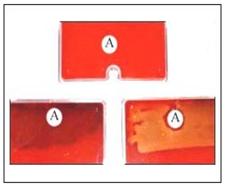
사진 67.세균배양 인큐베이터 속에 넣기 바로 전 피검 물 점액을 묻힌 혈액 우무 세균배양지(상)
A군 베타 용혈성 연쇄상구균이 아닌 잡균이 자란 세균배양지(하좌)
A군 베타 용혈성 연쇄상구균이 아닌 다른 종류의 연구균이 자란 혈액 우무 세균 배양지(하우)
A는 택소이다. 택소는 많은 종류의 연쇄상구균의 군종들 중 A군만 배양 검출하는 데 쓰는 항생제 디스크이다.
A 택소의 바로 주위에는 A군 연구균이 자라지 못해 원래 혈핵 우무 세균배양지의 색과 거의 비슷한 색으로 보인다.
Copyright ⓒ 2012 John Sangwon Lee, MD., FAAP
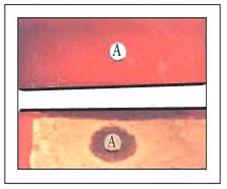
사진 68.세균배양 인큐베이터 속에 넣었던 혈액 우무세균 배양지에 A군 베타 용혈성 연쇄상구균은 자라기 않고 잡균만 자랐다(상). A군 베타 용혈성 연쇄상구균만 혈액 우무세균 배양지에 자랐다(하).
A는 택소이다. 택소는 많은 종류의 연쇄상구균의 군종들 중 A군만 배양 검출하는 데 쓰는 항생제 디스크이다.
A 택소의 바로 주위에는 A군 연구균이 자라지 못해 원래 혈액 우무 세균배양지의 색과 거의 비슷한 색으로 보인다.
Copyright ⓒ 2012 John Sangwon Lee, MD., FAAP

사진 69. A군 베타 용혈성 연쇄상구균 항원 항체 응집 반응검사가 음성으로 나타난 것. 이런 항원 항체 응집 반응검사는 불과 5~10분 이내 할 수 있고 이 검사로 인두염이나 편도염을 일으킨 세균이 A군 베타 용혈성 연쇄상구균인지 알 수 있다.
Copyright ⓒ 2012 John Sangwon Lee, MD., FAAP
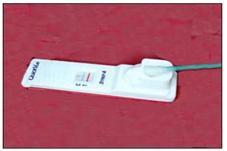
사진 70. A군 베타 용혈성 연쇄상구균 항원 항체 응집 반응검사가 양성으로 나타난 것
요즘 새로 나온 BioStar Strep A Ola Max rapid strep test로 항원 항체 응집 반응 검사를 하면 그 검사 결과가 96% 특이성 진단 가치가 있다. 그래서 A군 베타 용혈성 연쇄상구균 배양 검사를 꼭 할 필요가 없고 이 검사만으로 A군 베타 용혈성 연쇄상구균 인두편도염을 진단하기에 충분한 조건이 된다고 한다.
Copyright ⓒ 2012 John Sangwon Lee, MD., FAAP
- 병력, 증상 징후, 진찰소견 등을 종합하여 이 병이 의심되면 인두 강 점막이나 편도선 점막에서 면봉으로 점액을 채취하여 그 피검 물로 A군 베타 용혈성 연쇄상구균 항원 항체 응집반응 검사를 하면 5-10분 이내에 결과를 알아 A군 베타 용혈성 연쇄상구균 인두 편도염에 걸려 있다고 진단할 수 있다.
- 또는 면봉에 묻은 점액으로 A군 베타 용혈성 연쇄상구균 세균배양 검사(스트렙토 배양 검사)를 해서 24시간 이내에 결과를 알 수 있고 이 병을 확진할 수 있다.
- 앞서 설명한 여러 가지 증상 징후와 인두 통이 있으면 바이러스 인두편도염이 있는지 A군 베타 용혈성 연쇄상구균으로 인해 생긴 박테리아 인두 편도염이 있는지 알아보아야 한다.
- 이때, 세균 배양 검사, 항원 항체 응집 반응 검사를 이용한다.
- 이러한 방법으로 인두염을 확실히 진단 받으려면 많은 진료비가 드는 것이 단점이며 결과적으로 소비자가 의료비를 지불하게 된다.
| A군 베타 용혈성 연쇄상구균 인두 편도염의 치료 |
- A군 베타 용혈성 연쇄상구균 인두 편도염은 페니실린, Benzathine penicillin G, 에리스로마이신, 또는 세팔로스포린(Cephalosporin)계 항생제 중 한 가지 항생제로 적절히 치료한다. 아목사실린, Clindamycin등으로도 치료할 수 있다.
- 세팔로스포린(Cephalosporins)계 항생제에는 Cephalexin, Cephadroxil, Cefuroxime, Cefpodoxime, Cefprozil, Cefixime, Ceftibuten, Cefdinir 등이 있다. 이 중 한 가지 항생제를 선택해 치료하면 페니실린으로 치료하는 것보다 더 효과가 있다고 한다. 소아 청소년 감염병-표 1-10 참조.
- 바이러스 감염으로 생긴 인두 편도염을 항생제로 치료에 아무런 치료효과가 없을 뿐만 아니라 그런 항생제에 의해서 부작용이 생길 수 있다.
- 그밖에 다른 여러 가지 이유로 항생제로 함부로 치료해서도 안 된다.
- A군 베타 용혈성 연쇄상구균 감염으로 인한 인두편도염은 페니실린이나 에리스로마이신 등으로 치료할 때 항생제 치료에 치료효과가 나면 치료시작 한지 1~2일 이내 열이 떨어지고 인두통과 아픈 전신 증상 징후가 거의 없어지는 것이 보통이다.
- 그러나 처방한 항생제를 적어도 10일간 꼭 복용해서 A군 베타 용혈성 연쇄상구균을 박멸시켜야 인두편도염이 재발되지 않는다.
- 항생제의 종류에 따라 치료 기간이 다를 수 있다.
- 열이 나고 인두가 아플 때는 타이레놀이나 모트린(Ibuprofen) 등으로 필요에 따라 치료한다.
- 열이 내리고 인두가 더 이상 아프지 않을 때까지 육체적 안정을 취한다.
- 적절한 항생제 치료를 시작한 지 24시간 이후부터 전반적으로 증상 징후가 호전되고 평상시 건강 상태로 점점 뒤돌아 가면 등교해도 된다.
- 인두에 아무런 약도 바를 필요 없고 인두 편도염을 앓았다고 해서 편도를 수술로 떼어내는 편도 절제 수술치료를 꼭 받을 필요도 없다. [부모도 반의사가 되어야 한다-소아가정간호백과]-제18권 소아청소년 이비인후 질환-편도 절제 수술 참조.
- A군 베타 용혈성 연쇄상구균은 다른 사람에게 잘 감염 된다. 그러므로 한 집안 식구들 중 누군가가 목구멍이 아프고 열이 나면서 앓으면 의사의 진단 치료를 곧 받아야 한다.
- 예방접종백신은 아직 없다.
- 의사가 처방한 대로 항생제를 일정한 기간 동안 꼭 다 복용해야 한다.
| 미크롤라이드(마이크로라이드) 항박테리아 항생물내성이 생기는 A군 베타 용혈성 연쇄상구균 |
- A군 베타 용혈성 연쇄상구균 감염으로 인한 편도염이나 인두염 등은 페니실린이나 에리스로 마이신 등 항생제로 과거에는 잘 치료됐었다. 그러나 요즘 미 전역에서 A군 베타 용혈성 연쇄상구균이 미크롤라이드(Microrides) 항생물질에 내성이 생겨 A군 베타 용혈성 연쇄상구균 감염으로 인한 편도염이나 인두염 등이 에리스로마이신 등 미크롤라이드 항생물질로 잘 치료되지 않아 문제가 생기고 있다.
인두 점액 면봉 채취 세균배양검사에서 배양된 뇌수막 구균에 관해
- 인두염만 있을 때 인두 점막층에서 면봉으르 채취한 점액 피검물로 병원 세균검사실에서 인두 세균배양검사를 했을 때 A군 베타 용혈성 연쇄상구균이 배양되고 뇌수막 구균(Neisseria meningitidis)도 동시 배양될 때도 있다. Neisseria meningitidis는 일과성 구강 균 무리에 속할 수도 있다.
- 뇌수막구균성 감염병이 신체 내 없다고 임상적으로 추정하면 이때 배양된 뇌수막구균은 정상 인두 상존균에 속한다고 추정할 수 있다. 그리고 뇌수막구균은 인두염을 일으키지 않는다. 따라서 세균배양검사에서 자란 뇌수막구균은 임상적으로 신빙성이 없는 세균으로 간주 할 때가 많다.
- 이때 A군 베타 용혈성 연쇄상구균에 의한 인두염만 치료하는 것이 일반적이다.
- 또 인두염이 A군 베타 용혈성 연쇄상구균 감염으로 생겼는지 다른 균 감염으로 생겼는지 또는 바이러스 감염으로 생겼는 지 알아보기 위해 동네 병원에서 인두 점액 세균배양 검사를 할 때는 인두 점액 세균 배양검사에서 A군 베타 용혈성 연쇄상구균이 자랐는지 안 자랐는지에만 초점을 맞추어 세균배양 검사를 하는 것이 보통이다.
|
정상 상호흡기 정상 균무리(균주) Normal Flora of the Upper Respiratory Tract(URT) (비 인두강, 구 인두강 정상 균무리(균주) NORMAL FLORA OF THE NASOPHARYNX AND OROPHARYNX)
■ 상기도 병원균으로 간주할 수 있는 세균 POSSIBLE PATHOGENS of the URT:
|
| 미 감염병 학회의 연쇄상 구균 인두염 진단 치료 가이드 |
Guidelines for Dignosis and treament of Group A streptococcal (GAS) pharyngitis- Updated
- 속성 항원 항체 응집검사로 진단하거나 인두점액 피검물로 연쇄상구군 세균 배양검사로 진단하고
- 소아 청소년 환아에서 속성 항원 항체 응집(반응)검사 결과가 음성으로 나타나면 인두 점액 피검물로 연쇄상구군 세균배양검사를 하여 확진하고
- 성인 환자에서는 속성 항원 항체 응집검사 결과가 음성으로 나타나도 인두 점액 피검물로 연쇄상구군 세균배양검사로 확진하지 않아도 된다.
- 기침, 콧물, 입안 궤양 등의 바이러스 감염의 증상 징후가 있으면 연쇄상구군 세균 검사를 않아도 된다.
• 형제자매가 연쇄상 구균에 의한 감염병이 있지 않으면 3세 이하 영유아들은 연쇄상구군 세균 검사를 하지 않아도 된다.
• 페니실린에 알레르가 없으면 Penicillin 또는 Amoxicillin으로 10일간 치료한다. .
• 페니실린에 알레르기가 있으면 Cephalosporin, Clindamycin, Clarithromycin, 또는 Azithromycin으로 치료한다. 소스 : IDSA Infectious Diseases Society of America Issues Strep Guidelines 2012년 9월HARVARD MEDICAL SCHOOL, INFECTIOUS DISEASES IN PRIMARY CARE OCTOBER 14-16, 2015
Group A streptococcal pharyngitis (Group A streptococcal pharyngotonsillitis)
Causes of group A beta-hemolytic streptococci (group A streptococci) pharyngeal tonsillitis
• Group A beta hemolytic streptococcus/Group A streptococcus infection only in the pharynx and pharyngitis is called group A beta-hemolytic streptococcus pharyngitis.
• When only tonsillitis occurs due to infection only to the tonsils, it is called group A beta-hemolytic streptococcal tonsillitis.
• When pharyngitis and tonsillitis occur simultaneously due to simultaneous infection of the pharynx and tonsils, it is called group A beta-hemolytic streptococcal pharyngotonsillitis or group A streptococcal pharyngitis.
• Although this is theoretical, in practice, since the pharynx and tonsils are connected to each other in a narrow pharyngeal cavity, the highly infectious group A beta-hemolytic streptococci not only infects the pharynx or tonsils, but simultaneously infects the pharynx and tonsils. It is common to have group A beta-hemolytic streptococcal pharyngitis and group A beta-hemolytic streptococcal tonsillitis at the same time.
• In other words, when group A beta-hemolytic streptococci infects the throat, that is, the pharyngeal cavity, it cannot infect only the pharynx or the tonsils separately.
• So, it is common to simultaneously infect the pharynx and tonsils and cause an infectious disease in both parts at the same time, resulting in group A beta-hemolytic streptococcal pharyngeal tonsillitis.
• When a pharyngeal infection occurs due to bacterial infection other than group A beta-hemolytic streptococcal infection or other viral infection such as adenovirus, similarly, an infectious disease does not occur only in the tonsils or in the pharynx, but in both the tonsils and the pharynx. it is common to happen
• Nevertheless, group A beta-hemolytic streptococcal pharyngitis, group A beta-hemolytic streptococcal pharyngotonsillitis, group A beta-hemolytic streptococcal tonsillitis, or group A streptococcal pharyngitis is treated as another clinical condition Doctors and patients often confuse them because they are treated together, sometimes called by different names, and sometimes with different names.
• Here, these four disease names are actually the same medical names.
Signs, symptoms of group A beta-hemolytic streptococcal pharyngeal tonsillitis

Photo 54. The tonsils are swollen and red due to group A beta-hemolytic streptococcal pharyngitis and tonsillitis. Source-Copyrightⓒ 2011 John Sangwon Lee, MD., FAAP

Photo 55. Group A Beta-hemolytic streptococcal pharyngitis and tonsillitis causes swollen tonsils and red soft palate. Minor tonsillitis is not seen here. A white gob is stuck on the tongue. Source-Copyrightⓒ 2011 John Sangwon Lee, MD. FAAP

Picture 56. Severe group A beta-hemolytic streptococcal pharyngitis and tonsillitis. The tonsils were swollen and there was red and white lumps. With uvula, the uvula is red and swollen. Source-Copyrightⓒ 2011 John Sangwon Lee, MD., FAAP

Picture 57. Severe group A beta-hemolytic strep pharyngitis and tonsillitis. Swollen and red tonsils are clogged. Source-Copyrightⓒ 2011 John Sangwon Lee, MD., FAAP

Photo 58. Group A beta-hemolytic streptococcal tonsillitis and pharyngitis Both tonsils were significantly enlarged due to tonsillitis. Source-Copyrightⓒ 2011 John Sangwon Lee, MD., FAAP

Photo 59. Both tonsils were slightly swollen due to group A beta-hemolytic streptococcal tonsillitis and pharyngitis. Source-Copyrightⓒ 2011 John Sangwon Lee, MD., FAAP

Picture 60. Group A beta-hemolytic streptococcal infection can cause tonsillitis and scarlet fever. As a symptom of scarlet fever, a white plaque may appear on the tongue, followed by a temporary change of the tongue to a red tongue color similar to the color of a red strawberry. Source-Copyrightⓒ 2011 John Sangwon Lee, MD., FAAP

Picture 61. A group A beta-hemolytic streptococcal infection occurred in the tonsils, and scarlet fever may also occur. As a symptom of scarlet fever, at first there may be white patches on the tongue, then the tongue may change to a tongue color similar to that of a red strawberry. Source-Copyrightⓒ 2011 John Sangwon Lee, MD., FAAP

Picture 62. Group A beta-hemolytic streptococcal infection can occur in the tonsils and pharynx, and scarlet fever can also occur. The scarlet fever peeled off the stratum corneum of the palm of the hand. Source-Copyrightⓒ 2011 John Sangwon Lee, MD., FAAP

Figure 63. Group A beta-hemolytic streptococcal infection can occur in the tonsils and scarlet fever. When you have scarlet fever, you may develop a skin rash that resembles sandpaper. The color of the skin rash is usually red. source; Used with permission from Health information service Merk Sharp & Dome, West Point, PA

Picture 64. Mucus is collected from the pharyngeal mucosa for testing for group A beta-hemolytic streptococcus bacteria or for antibody antigen emergency response testing. Source-Copyright ⓒ 2012 John Sangwon Lee, MD., FAAP
Symptoms and signs of group A beta-hemolytic streptococcal (sex) pharyngotonsillitis are as follows, depending on age, disease course, and complications.
• The tonsils become red, swollen, sore and enlarged, and the throat is very sore.
• You also have low or high fever, and symptoms such as headache, abdominal pain, and vomiting occur, causing pain in the limbs and the whole body.
• It is normal for the child to be in a toxic state.
• If you look into the pharyngeal cavity and tonsils in the throat with a lamp, you can see that the tonsils, the mucous membrane of the pharyngeal cavity, and the soft palate are red.
• Two or three days after the onset of this disease, it is easy to see that the tonsils are covered with white pus and mucus, and the tonsils are greatly swollen.
• Lymph nodes in the neck area just below the chin may swell and may be slightly painful to touch.
• This disease usually gets progressively worse if it is not treated properly with antibiotics in the early stages. • As it gets worse, the sore throat gets worse and worse, making it difficult to swallow saliva and food.
• Sometimes the child looks very sick and does not like to play and only wants to sleep.
• You may fall into a toxic state.
• Loss of appetite, eating poorly, sleeping abnormally, or sometimes not sleeping well because of pain.
• Group A beta-hemolytic streptococci have several types of strains, and among them, there are strains that produce redness toxin. Infection with the red toxin-producing strain can cause pharyngotonsillitis, and infection with that strain can cause scarlet fever. see scarlet fever
• Group A beta-hemolytic streptococcal pharyngotonsillitis is treated as group A beta-hemolytic streptococcal when there are symptoms of skin rash, first, white lumps on the tongue, and then the tongue turns red similar to the color of red strawberries. Instead of diagnosing it with the name of coccal pharyngotonsillitis, it is diagnosed with scarlet fever.
• If pharyngeal tonsillitis caused by group A beta-hemolytic streptococcal infection is not properly treated, various complications such as life-threatening acute glomerulonephritis and rheumatic fever can occur. www.drleepediatrics.com-Volume 11 Children and adolescents cardiovascular disease-rheumatic fever, rheumatic carditis, sepsis, otitis media, sinusitis, osteomyelitis, see rheumatoid arthritis.
Diagnosis of group A beta-hemolytic streptococcal pharyngitis

Figure 65 .In order to culture group A beta-hemolytic streptococci or to test for agglutination reaction with group A beta-hemolytic streptococcus antigen, mucus is collected from the mucous membrane of the pharynx or tonsils with a cotton swab. Source-Copyright ⓒ 2012 John Sangwon Lee, MD.. FAAP

Picture 66. The mucus collected from the pharyngeal mucosal layer is immersed in a blood agar culture paper, and the culture medium is placed in an incubator for bacterial culture and cultured for 24 hours. These tests can be easily performed at a local hospital. The diagnostic accuracy is good, but the test cost is high. Copyright ⓒ 2012 John Sangwon Lee, MD., FAAP

Picture 67. Blood agar culture paper (top) with blood agar mucus to be tested just before putting it in the bacterial culture incubator Bacterial culture medium grown with various bacteria other than group A beta-hemolytic streptococci (bottom left) Blood agar culture medium grown with research bacteria other than group A beta-hemolytic streptococci (how) A is taxo. Taxo is an antibiotic disk used to culture and detect only group A among many strains of streptococci. Group A research bacteria do not grow right around the A taxo, so the color appears to be almost similar to the color of the original hemonuclear agar culture medium. Copyright ⓒ 2012 John Sangwon Lee, MD., FAAP

Picture 68. In the blood agar culture medium placed in the bacterial culture incubator, group A beta-hemolytic streptococci did not grow, only various bacteria (top). Only group A beta-hemolytic streptococci were grown on a blood agar culture medium (bottom). A is taxo. Taxo is an antibiotic disk used to culture and detect only group A among many strains of streptococci. Group A research bacteria do not grow right around the taxo A, so the color looks almost similar to the color of the original blood agar culture paper. Copyright ⓒ 2012 John Sangwon Lee, MD., FAAP

Photo 69. A group A beta-hemolytic streptococcal antigen antibody agglutination test was negative. This antigen-antibody aggregation reaction test can be done within only 5 to 10 minutes, and this test can determine whether the bacteria that caused pharyngitis or tonsillitis is group A beta-hemolytic streptococci. Copyright ⓒ 2012 John Sangwon Lee, MD., FAAP

Photo 70. A positive group A beta-hemolytic streptococcal antigen antibody agglutination test When the antigen-antibody aggregation reaction test is performed with the recently released BioStar Strep A Ola Max rapid strep test, the test result has a 96% specific diagnostic value. Therefore, there is no need to perform a group A beta-hemolytic streptococcus culture test, and this test alone is a sufficient condition for diagnosing group A beta-hemolytic streptococcal pharyngotonsillitis. Copyright ⓒ 2012 John Sangwon Lee, MD., FAAP
• If this disease is suspected based on medical history, symptom signs, and examination findings, mucus is collected from the mucous membrane of the oropharyngeal cavity or tonsil with a cotton swab, and the sample is tested for agglutination reaction with group A beta-hemolytic streptococcus antigen for 5-10 minutes It can be diagnosed as having group A beta-hemolytic streptococcal pharyngeal tonsillitis by knowing the results within a few days.
• Alternatively, a group A beta hemolytic streptococcal bacterial culture test (streptococcal culture test) can be performed with mucus on a cotton swab and the result can be known within 24 hours and the disease can be confirmed.
• If you have any of the symptoms and sore throats described above, you should determine if you have viral pharyngotonsillitis or bacterial pharyngotonsillitis caused by group A beta-hemolytic streptococcus.
• In this case, bacterial culture test and antigen-antibody aggregation test are used.
• In order to be diagnosed with pharyngitis in this way, the disadvantage is that it costs a lot of medical expenses, and as a result, the consumer pays the medical expenses.
Treatment of group A beta-hemolytic streptococcal pharyngeal tonsillitis
• Group A beta-hemolytic streptococcal pharyngeal tonsillitis is appropriately treated with one of penicillin, Benzathine penicillin G, erythromycin, or cephalosporin antibiotics. It can also be treated with amoxacillin or clindamycin.
• Cephalosporins antibiotics include Cephalexin, Cephadroxil, Cefuroxime, Cefpodoxime, Cefprozil, Cefixime, Ceftibuten, and Cefdinir. It is said that treatment with one of these antibiotics is more effective than treatment with penicillin. Infectious diseases in children and adolescents – see Table 1-10.
• Antibiotics for pharyngeal tonsillitis caused by viral infection have no therapeutic effect, and such antibiotics may cause side effects.
• For many other reasons, antibiotics should not be tampered with.
• For pharyngotonsillitis caused by group A beta-hemolytic streptococcus infection, when treated with penicillin or erythromycin, if antibiotic treatment is effective, the fever will drop within 1 to 2 days after the start of treatment, and sore throat and symptoms of painful systemic symptoms will almost disappear. is average.
• However, the prescribed antibiotics must be taken for at least 10 days to eradicate group A beta-hemolytic streptococci to prevent recurrence of pharyngotonsillitis.
• Treatment duration may vary depending on the type of antibiotic.
• If you have a fever or sore throat, treat with Tylenol or Motrin (Ibuprofen) as needed.
• Rest physically until the fever subsides and the pharynx is no longer sore.
• After 24 hours of initiation of appropriate antibiotic treatment, symptoms generally improve and students can return to school as soon as they return to normal health.
• There is no need to apply any medicine to the pharynx, and if you have pharyngeal tonsillitis, you do not need to undergo tonsillectomy, which involves surgical removal of your tonsils. www.drleepdiatrics.com – Volume 18 Children and Adolescent Otolaryngology – Refer to tonsillectomy.
• Group A beta-hemolytic streptococci infect others. Therefore, if someone in your household becomes ill with a sore throat and fever, you should seek medical attention immediately.
• There is no vaccine yet.
• Be sure to take all of your antibiotics for a period of time as prescribed by your doctor. Group A beta-hemolytic streptococci with microlide (microlide) antibacterial antibiotic resistance
• Tonsillitis and pharyngitis caused by group A beta-hemolytic streptococcal infection were treated well in the past with antibiotics such as penicillin and erythromycin.
However, as group A beta-hemolytic streptococci have become resistant to microrides antibiotics across the United States these days, tonsillitis or pharyngitis caused by group A beta-hemolytic streptococcus infection is not well treated with microlides such as erythromycin. no problem is occurring
About meningococci cultured in pharyngeal mucus swabs and bacterial cultures
• When there is pharyngitis alone, when a pharyngeal bacterium culture test is performed in a hospital bacteriological laboratory with a mucus sample taken from the pharyngeal mucosal layer, group A beta-hemolytic streptococci are also co-cultured with Neisseria meningitidis. Neisseria meningitidis may also belong to the transient oral flora.
• If it is clinically assumed that there is no meningococcal infectious disease in the body, it can be assumed that the cultured meningococci belong to normal pharyngeal bacteria. And meningococci do not cause pharyngitis. Therefore, meningococci grown in bacterial culture are often regarded as clinically unreliable bacteria.
• In this case, it is common to treat only pharyngitis caused by group A beta-hemolytic streptococci.
• Also, when a pharyngeal mucus culture test is performed at a local hospital to determine whether the pharyngitis is caused by a group A beta-hemolytic streptococcal infection, another bacterial infection, or a viral infection, the pharyngeal mucus culture test is It is common to conduct a bacterial culture test focusing only on whether or not it has grown.
Normal Flora of the Upper Respiratory Tract (URT) (Normal FLORA OF THE NASOPHARYNX AND OROPHARYNX)
• Nonhemolytic streptococci
• Staphylococci
• Micrococci
• Moraxella catarrhalis
• Lactobacillus spp
• Corynebacterium spp
• Coagulase-negative staphylococci
• Neisseria spp (not N. gonorrhea or N. meningitidis)
• Veillonella spp
• Spirochetes
■ Bacteria that can be considered upper respiratory tract pathogens POSSIBLE PATHOGENS of the URT:
• Acinetobacter,
• Viridans streptococci,
• B-hemolytic streptococci,
• Streptococcus pneunoniae,
• Staphylococcus aureus,
• Corynebacterium diptheriae,
• Neisseria meningitidis;
• Cryptococcus neoformans,
• Mycoplasma spp;
• Haemophilus influenzae,
• Haemophilus parainfluenzae,
• Branhamella catarrhalis,
• Candida albicans,
• Herpes simplex virus,
• Enterobacteriaceae,
• Mycobacterium spp;
• Pseudomonas spp,
• Filamentous fungi,
• Klebsiella ozaenae,
• Eikenella corrodens,
• Bacteroides spp,
• Peptostreptococcus spp;
• Actinomyces spp. American Society of Infectious Diseases Guide to Diagnosis and Treatment of Streptococcal Pharyngitis Guidelines for Dignosis and treament of Group A streptococcal (GAS) pharyngitis- Updated
• Diagnosed by rapid antigen-antibody aggregation test or by streptococcal bacterial culture test with pharyngeal mucus specimen
• If the rapid antigen-antibody aggregation (reaction) test result is negative in children and adolescents, confirm the diagnosis by performing a streptococcal bacterial culture test with a specimen of pharyngeal mucus.
• In adult patients, even if the rapid antigen-antibody aggregation test result is negative, it is not necessary to confirm the diagnosis by a streptococcal culture test with a specimen of pharyngeal mucus.
• If you have symptoms of a viral infection, such as cough, runny nose, or mouth sores, you do not need to be tested for streptococcus.
• Children under the age of 3 do not need to be tested for streptococci unless their sibling has a streptococcal infection. • If you are not allergic to penicillin, treat with Penicillin or Amoxicillin for 10 days.
• If you are allergic to penicillin, treat with Cephalosporin, Clindamycin, Clarithromycin, or Azithromycin. Source: IDSA Infectious Diseases Society of America Issues Strep Guidelines September 2012HARVARD MEDICAL SCHOOL, INFECTIOUS DISEASES IN PRIMARY CARE OCTOBER 14-16, 2015
출처 및 참조 문헌
-
Pediatric Nutritional Handbook American Academy of Pediatrics
-
소아가정간호백과–부모도 반의사가 되어야 한다, 이상원
-
The pregnancy Bible. By Joan stone, MD. Keith Eddleman, MD
-
Neonatology Jeffrey J. Pomerance, C. Joan Richardson
-
Preparation for Birth. Beverly Savage and Dianna Smith
-
임신에서 신생아 돌보기까지. 이상원
-
Breastfeeding by Ruth Lawrence and Robert Lawrence
-
Nelson Textbook of Pediatrics 14th ed. Beherman,
-
The Johns Hopkins Hospital, The Harriet Lane Handbook, 18th edition
-
Red book 29th edition 2012
-
Nelson Text Book of Pediatrics 19th Edition
-
Infectious disease of children, Saul Krugman, Samuel L Katz, Ann A. Gershon, Catherine Wilfert
-
The Harriet Lane Handbook 19th Edition
-
제8권 소아청소년 호흡기 질환 참조문헌 및 출처
-
Sources and references on Growth, Development, Cares, and Diseases of Newborn Infants
-
Emergency Medical Service for Children, By Ross Lab. May 1989. p.10
-
Emergency care, Harvey grant and Robert Murray
-
Emergency Care Transportation of Sick and Injured American Academy of Orthopaedic Surgeons
-
Emergency Pediatrics A Guide to Ambulatory Care, Roger M. Barkin, Peter Rosen
-
Quick Reference To Pediatric Emergencies, Delmer J. Pascoe, M.D., Moses Grossman, M.D. with 26 contributors
-
Neonatal resuscitation American academy of pediatrics
-
소아과학 대한교과서
- www.drleepediatrics.com 제1권 소아청소년 응급 의료
- www.drleepediatrics.com 제2권 소아청소년 예방
- www.drleepediatrics.com 제3권 소아청소년 성장 발육 육아
- www.drleepediatrics.com 제4권 모유,모유수유, 이유
- www.drleepediatrics.com 제5권 인공영양, 우유, 이유식, 비타민, 미네랄, 단백질, 탄수화물, 지방
- www.drleepediatrics.com 제6권 신생아 성장 발육 육아 질병
- www.drleepediatrics.com제7권 소아청소년 감염병
- www.drleepediatrics.com제8권 소아청소년 호흡기 질환
- www.drleepediatrics.com제9권 소아청소년 소화기 질환
- www.drleepediatrics.com제10권. 소아청소년 신장 비뇨 생식기 질환
- www.drleepediatrics.com제11권. 소아청소년 심장 혈관계 질환
- www.drleepediatrics.com제12권. 소아청소년 신경 정신 질환, 행동 수면 문제
- www.drleepediatrics.com제13권. 소아청소년 혈액, 림프, 종양 질환
- www.drleepediatrics.com제14권. 소아청소년 내분비, 유전, 염색체, 대사, 희귀병
- www.drleepediatrics.com제15권. 소아청소년 알레르기, 자가 면역질환
- www.drleepediatrics.com제16권. 소아청소년 정형외과 질환
- www.drleepediatrics.com제17권. 소아청소년 피부 질환
- www.drleepediatrics.com제18권. 소아청소년 이비인후(귀 코 인두 후두) 질환
- www.drleepediatrics.com제19권. 소아청소년 안과 (눈)질환
- www.drleepediatrics.com 제20권 소아청소년 이 (치아)질환
- www.drleepediatrics.com 제21권 소아청소년 가정 학교 간호
- www.drleepediatrics.com 제22권 아들 딸 이렇게 사랑해 키우세요
- www.drleepediatrics.com 제23권 사춘기 아이들의 성장 발육 질병
- www.drleepediatrics.com 제24권 소아청소년 성교육
- www.drleepediatrics.com 제25권 임신, 분만, 출산, 신생아 돌보기
- Red book 29th-31st edition 2021
- Nelson Text Book of Pediatrics 19th- 21st Edition
- The Johns Hopkins Hospital, The Harriet Lane Handbook, 22nd edition
- 응급환자관리 정담미디어
- Pediatric Nutritional Handbook American Academy of Pediatrics
- 소아가정간호백과–부모도 반의사가 되어야 한다, 이상원 저
- The pregnancy Bible. By Joan stone, MD. Keith Eddleman, MD
- Neonatology Jeffrey J. Pomerance, C. Joan Richardson
- Preparation for Birth. Beverly Savage and Dianna Smith
- 임신에서 신생아 돌보기까지. 이상원
- Breastfeeding. by Ruth Lawrence and Robert Lawrence
- Sources and references on Growth, Development, Cares, and Diseases of Newborn Infants
- Emergency Medical Service for Children, By Ross Lab. May 1989. p.10
- Emergency care, Harvey Grant and Robert Murray
- Emergency Care Transportation of Sick and Injured American Academy of Orthopaedic Surgeons
- Emergency Pediatrics A Guide to Ambulatory Care, Roger M. Barkin, Peter Rosen
- Quick Reference To Pediatric Emergencies, Delmer J. Pascoe, M.D., Moses Grossman, M.D. with 26 contributors
- Neonatal resuscitation Ameican academy of pediatrics
- Pediatric Nutritional Handbook American Academy of Pediatrics
- Pediatric Resuscitation Pediatric Clinics of North America, Stephen M. Schexnayder, M.D.
-
Pediatric Critical Care, Pediatric Clinics of North America, James P. Orlowski, M.D.
-
Preparation for Birth. Beverly Savage and Dianna Smith
-
Infectious disease of children, Saul Krugman, Samuel L Katz, Ann A.
- 제4권 모유, 모유수유, 이유 참조문헌 및 출처
- 제5권 인공영양, 우유, 이유, 비타민, 단백질, 지방 탄수 화물 참조문헌 및 출처
- 제6권 신생아 성장발육 양호 질병 참조문헌 및 출처
- 소아과학 대한교과서
Copyright ⓒ 2014 John Sangwon Lee, MD., FAAP
“부모도 반의사가 되어야 한다”-내용은 여러분들의 의사로부터 얻은 정보와 진료를 대신할 수 없습니다.
“The information contained in this publication should not be used as a substitute for the medical care and advice of your doctor. There may be variations in treatment that your doctor may recommend based on individual facts and circumstances.
“Parental education is the best medicine.